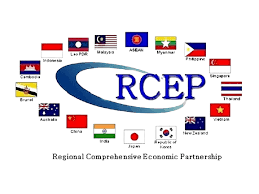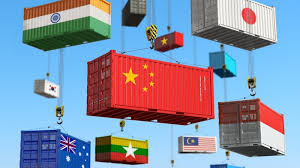


Daily Updates | July 15, 2025
LEGAL IMPLICATIONS OF WITHDRAWAL OF INDIA FROM RCEP TRADE AGREEMENT
Written by Aishwarya Srivastava BHARATI VIDYAPEETH UNIVERSITY
Introduction:
India’s decision to opt out of the Regional Comprehensive Economic Partnership (RCEP) in November 2019 marked a critical juncture in its trade diplomacy. As the world’s largest trade agreement, RCEP involves fifteen countries, including ASEAN members, China, Japan, South Korea, Australia, and New Zealand. India’s withdrawal raised legal, economic, and geopolitical concerns, especially as it was deeply involved in the negotiation process for nearly a decade.
This research paper explores the rationale behind India’s exit, the legal implications under international law and Indian constitutional framework, and proposes policy perspectives. It also includes my opinion on whether the decision was prudent in light of India’s trade and development goals.
Legal Framework and Context:
1. Understanding RCEP
RCEP is a mega-regional trade agreement aimed at consolidating existing ASEAN+1 FTAs into a unified framework. It covers trade in goods, services, investment, intellectual property, and e-commerce. The final agreement, signed on 15 November 2020, excludes India despite its active participation until the final stage.
2. India’s Legal Capacity to Enter and Withdraw
Under Article 253 of the Indian Constitution, Parliament has the power to make laws for implementing treaties. Entry into and exit from international treaties, however, is the prerogative of the executive (Central Government), particularly the Ministry of External Affairs and Ministry of Commerce and Industry. No formal ratification or parliamentary approval is required unless domestic legislation is impacted, as affirmed by the Supreme Court in Maganbhai Ishwarbhai Patel v. Union of India (1969 AIR 783).
India, having never signed RCEP, did not need a formal withdrawal. It simply refused to sign the final agreement.
Analysis:
I. Reasons Behind India’s Withdrawal
India cited a mix of economic, strategic, and legal concerns for not joining RCEP:
A. Trade Deficit and Market Access Concerns
India’s trade deficit with RCEP nations, especially China, stood at over $105 billion in 2019. Critics feared that RCEP would exacerbate this gap. The lack of adequate safeguards or tariff protection mechanisms worried Indian industries such as dairy, agriculture, and manufacturing.
B. Rules of Origin and Dumping Risk
The RCEP’s lenient “rules of origin” provisions could allow goods from non-member countries like China to be routed through ASEAN states, taking undue advantage of tariff concessions.
C. Lack of Adequate Safeguards
India demanded an automatic safeguard mechanism (ASM) to protect domestic industries from sudden import surges. This demand remained unmet, leading to legal uncertainty about India’s ability to invoke trade remedies under WTO norms while still being bound by RCEP’s obligations.
D. Data Sovereignty and Investment Clauses
India expressed concerns about clauses related to e-commerce, particularly those requiring free cross-border data flows. India is still finalising its data protection regime. Joining RCEP could have limited its policy space in this area.
E. Concerns Over ISDS (Investor-State Dispute Settlement)
ISDS provisions would allow foreign investors to sue the Indian government in international arbitration over regulatory changes. Given India’s experience in such disputes, notably with Vodafone and Cairn Energy, policymakers feared legal entrapment under future investment claims.
II. Legal Implications of India’s Withdrawal
A. Under International Law
India’s non-signature does not trigger legal consequences under international law. According to the Vienna Convention on the Law of Treaties, 1969, a state incurs no obligations under a treaty it has not ratified or acceded to.
However, India’s withdrawal may affect its credibility as a negotiator. Customary international law respects sovereignty, but repeated disengagements from negotiations may signal unpredictability in foreign policy.
B. Trade Law and WTO Consistency
India’s trade regime remains governed by WTO principles. Any bilateral or multilateral arrangement must comply with Article XXIV of GATT 1994, which allows regional trade agreements if they cover “substantially all the trade” and reduce tariffs mutually.
By staying out of RCEP, India retains full autonomy to use safeguard duties, anti-dumping measures, and quantitative restrictions permitted under the WTO framework, such as those invoked under Section 9A of the Customs Tariff Act, 19754.
C. Domestic Legal Autonomy
Not joining RCEP helps India preserve its legislative and regulatory independence in key sectors like agriculture, pharmaceuticals, and digital economy. Domestic policymaking remains unaffected by supranational treaty commitments or ISDS arbitration, which often constrain regulatory power.
III. Counterarguments and Missed Opportunities
Critics argue that India’s decision may have long-term consequences:
- Isolation from regional supply chains: With global trade increasingly organized around regional blocs, India risks exclusion from value chains in Asia.
- Loss of first-mover advantage: RCEP creates standards India will now have to accept without influencing them.
- Signal of protectionism: The decision could be read as regressive, especially at a time when India is aspiring to be a global investment destination.
My Opinion:
As a law student, I believe India’s exit from RCEP was a prudent move, though not without costs. From a legal standpoint, maintaining the flexibility to regulate sensitive sectors is critical for a developing economy. The lack of enforceable protections in RCEP, especially for MSMEs, agriculture, and digital sovereignty, could have led to litigations and economic vulnerabilities. However, India must now act decisively to conclude pending trade deals (like with the EU, UK, and Canada) and improve its domestic industries to prevent marginalization. In future, India should only join such agreements after ensuring full preparedness and public consultation. In essence, India should be globally ambitious but legally cautious—a stance that aligns with its constitutional values and strategic interests.
Conclusion:
India’s decision to stay out of RCEP reflects a cautious, interest-based trade policy rather than a retreat from globalization. It demonstrates a legal awareness of domestic vulnerabilities, sovereignty concerns, and the need to modernize internal frameworks before taking on deeper international obligations.
Legally, India's withdrawal is valid, sovereign, and strategically sound under both domestic and international law. However, its long-term success depends on how effectively India reforms its trade infrastructure and re-engages through balanced bilateral agreements.
References:
- Press Information Bureau, “India’s stand on RCEP Agreement,” Ministry of Commerce & Industry
- S. Bhalla, “India’s RCEP Dilemma,” Indian Council for Research on International Economic Relations
- P. Mehta, “Data Sovereignty vs. Trade Commitments: The RCEP Tug-of-War,” Economic and Political Weekly
- Customs Tariff Act, 1975, Section 9A (India)



Comments (0)